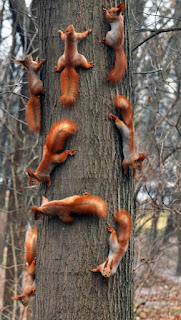 |
| It would be nice if this could be a common sight in the UK |
The article did not suggest any theories about why the population has rebounded so strongly. However, it did mention that the area is one of pine forests, which is the most favorable habitat for the red squirrels. It is likely that the survivors of the epidemic have passed on some resistance to the virus to their offspring, which would help ensure greater survival rates in the event of a future outbreak of the disease.
By far the most important thing that humans can do to help this population of red squirrels continue to grow is to protect the remaining pine forest habitat, and hopefully set aside areas where additional pine forest can grow. The article made no mention of culling of grey squirrels in the area, and I hope that this loathsome and cruel practice has not been carried out there. Grey squirrel culling will not bring about sustainable recovery of the red squirrel population. This can only be accomplished through habitat protection focusing on pine forests in the norther parts of England and in Scotland.
 |
| With your help we can both survive! |
Hi there. Good to hear the Red squirrel numbers appear to be up in the Liverpool area. I live in Toronto, Canada, and earlier this year, my wife, Jean, and I were in Ireland where we came upon the rarely seen Red Squirrel. To us, they actually look somewhat like our American Red squirrels, but boy, do they have long ears! We were shocked to learn that U.K. and Irish Red squirrels are contracting the pox virus from Grey squirrels, and dying. We feel very lucky to have seen two Red squirrels in Ireland, and have posted some of our pictures and videos for anyone interested at: http://frametoframe.ca/photo-essay-red-grey-squirrels-canada-ireland
ReplyDeleteI Have Eurasian Red Squirrel and American Red Squirrel Pet
ReplyDeletegoogle 2903
ReplyDeletegoogle 2904
google 2905
google 2906